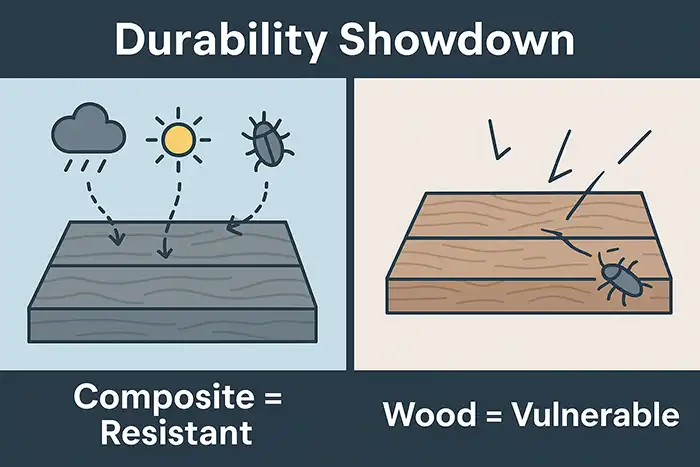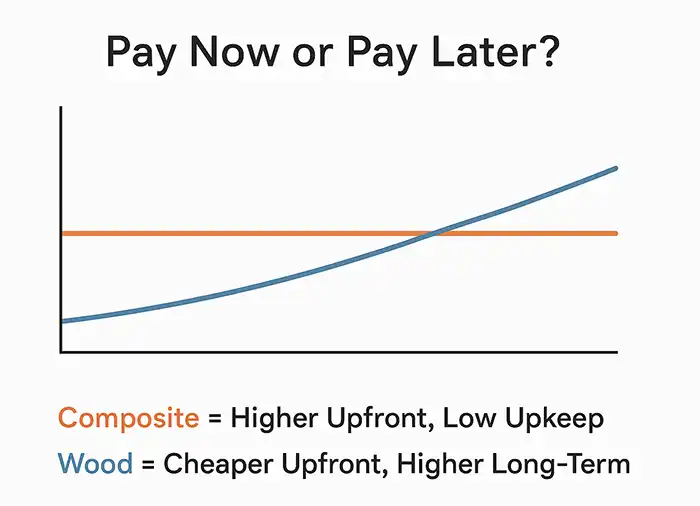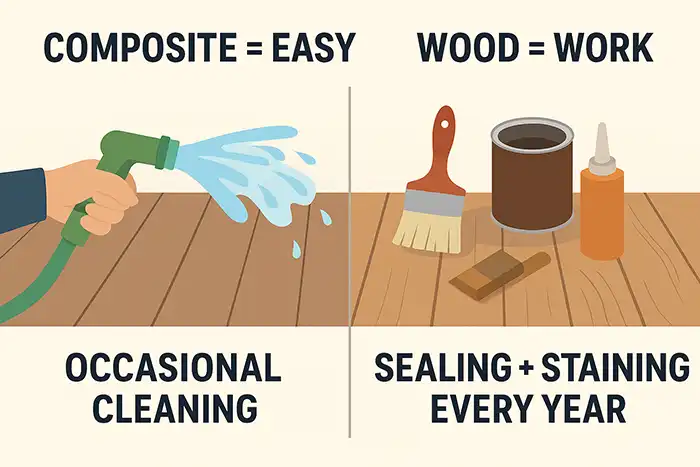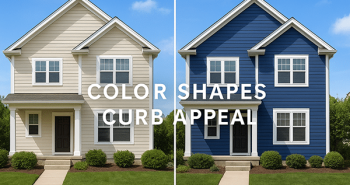Choosing the right materials for your deck installation requires some background knowledge and understanding. You need to know things like style options, maintenance requirements, and short- vs. long-term costs. And, while most new decks will come with a warranty, that doesn’t necessarily mean you’ll be protected from future expenses if there are any issues. To help you determine which material is better for you, here are a few pros and cons of composite decking when compared to wood decks.
In this article, some things you’ll learn include:

Which decking material is easier to maintain? Composite decks need minimal upkeep, while wood requires regular sealing, staining, and repairs to stay in good shape.
How long does each type of deck last? Composite decking can last 25–50 years, but well-maintained wood decks can still reach 20–25 years.
What about looks and style? Wood offers a natural, authentic appearance that can be customized with stains, while composite comes in a variety of colors and textures that mimic wood.
Which decking option is safer and more durable? Composite resists splintering, warping, and insect damage, while wood is more vulnerable to the elements.
How do costs compare? Wood is cheaper upfront, but composite often saves money over time due to lower maintenance and longer lifespan.
Which is better for the environment? Composite decking often uses recycled materials, whereas wood can require new lumber and chemical treatments.
What Is Composite Decking?
Composite decking is a type of building material made from a blend of recycled materials, namely wood fibers and plastic. The wood fibers give it a wood-like appearance, making it an excellent option for homeowners who want a natural look with minimal maintenance. Since composite decking boards contain recycled plastics, there’s added strength, and they’re more resistant to water damage over time. The wood-plastic composite also helps reduce the risk of insect damage and may lower maintenance costs over time. Unlike traditional lumber, composite boards don’t warp, splinter, or rot, and they’re designed to last for decades with minimal upkeep. For homeowners who want the appearance of wood without the hassle, composite is a strong contender.
What is Wood Decking?
Traditional wood decking is made from natural lumber, either from softwoods like pine, cedar, or redwood, or more durable hardwoods such as ipe, teak, or mahogany. Real wood has been the classic choice for decks for decades because it offers a warm, natural look that many homeowners love, but it’s prone to decay over time. This depends on several factors like location, weather, treatment, and annual maintenance, so it’s important to talk to your decking contractor to understand how to care for real wood decking properly. This includes correctly staining and sealing your deck at regular intervals. You can also choose pressure-treated options, which make wood decks more resistant to factors like water and insect damage.
Key Benefits of Composite Decking Over Wood
When comparing composite materials to traditional wood for your decking options, there are a few advantages to the former. Some of the most notable benefits of composite decks include the following:
1. Low Maintenance
One of the most significant advantages of composite decking is its low maintenance requirements. Unlike wood, which needs regular staining, sealing, or painting, composite only requires an occasional wash with soap and water. It doesn’t need to be sanded or stained to maintain its overall look and feel, making its long-term value great for homeowners who don’t want to deal with ongoing costs. It’s also preferable for those who don’t have the time to care for their outdoor space regularly.
2. Durability and Longevity
Composite decking is designed for longevity, and can typically last between 25 and 50 years, depending on the type of product you choose and the quality of materials. This makes it an excellent long-term investment, even though it may have a higher initial cost.
Wood, on the other hand, is vulnerable to weather changes, termites, and moisture damage. If you’re asking yourself, “Which lasts longer, composite or wood decking?” the answer is almost always composite. However, it’s essential to speak to your decking professional to understand your options thoroughly.
3. Eco-Friendly Choice
Most composite decking materials are made from recycled materials like recycled plastic and reclaimed wood, meaning they’re more environmentally friendly than new wooden decks. If sustainability is an important consideration when creating your dream deck, composite is the greener choice compared to lumber that requires deforestation and ongoing chemical treatments. However, because of the eco-friendly materials that the composite is made from, the surface may become hotter than traditional wood, especially if you live in a particularly sunny area. Though there are some brands that offer unique cooling technology to combat this problem.
4. Variety of Colors and Styles
Composite boards come in a wide range of colors, textures, and finishes, giving you more design flexibility. You can choose a look that mimics natural wood grain or go for a sleek, modern aesthetic. However, it’s important to remember that, even though the technology is advancing, recycled materials won’t be able to create results that look 100% natural. Still, the colors tend to stay vibrant for years, and you won’t have to re-stain to maintain your initial design.
5. Better Value Over Time
The upfront costs of composite decking are typically higher than for wood decks, but long-term savings on maintenance and replacement often make it the more cost-effective choice. Wood decking requires ongoing maintenance and repairs that can add up over time, but when homeowners stay on top of these, the lifespan of wood can be drastically improved. Still, installing composite decking is often seen as an investment that tends to pay off in reduced upkeep and even increased home value over time.
Are There Any Benefits of a Traditional Wood Deck?
Choosing the right decking material is a highly personal choice, and even though there are several benefits of composite materials, that doesn’t mean wood decking is inherently bad. In fact, many people find that maintaining a wood deck is an art and an opportunity to change the overall look and feel of the space without having to completely renovate the area. By simply changing the stain and the sealant, wood can go from light and traditional to dark and modern. Plus, even though the technology of composite decking offers a similar look and feel to real wood, it still can’t perfectly mimic the natural grain pattern that you find in various wood species.
Additionally, even though composite decking is more expensive initially, maintenance can still ensure that a wood deck lasts up to 25 years or more, especially if you utilize options like pressure-treated pine. Of course, poor maintenance will lead to a shorter lifespan, but there are several things you can do to protect your wooden deck and get the most out of your investment. There are several advantages of wood decking as well, so it’s best to thoroughly explore your options to make sure you have a strong peace of mind about which material is best for you.
Composite vs. Wood Decking: A Quick Comparison
Here are a few of the most notable things to consider when comparing composite decking vs. wood decking.
| Feature | Composite Decking | Traditional Wood |
| Maintenance | width=”178″Occasional cleaning | Annual sealing, staining, and painting |
| Lifespan | 25-50 years | 10–15 years |
| Durability | Resistant to rot, fading, and insects | Vulnerable to moisture, pests, and warping |
| Safety | Splinter-free, slip-resistant | Can splinter, warp, and crack |
| Cost | Higher upfront | Lower upfront, higher long-term |
Common Questions About Composite Decking
Is composite decking worth it?
Yes, if you value durability, low maintenance, and long-term savings, composite decking is well worth the investment.
How long does composite decking last?
Most composite decks last 25 to 50 years, which can be about twice as long as some of the pressure-treated wood options.
Does composite decking get hot?
Composite materials can get hot in direct sunlight, but some brands are engineered with heat-resistant technology.
Can you pressure wash composite decking?
Yes, but it’s best to use a low-pressure setting to avoid damaging the surface.
Can composite decking be painted or stained?
While it’s possible, it’s generally unnecessary because composite boards are designed to retain their color for years. Painting or staining can also void the manufacturer’s warranty.

Is composite decking environmentally friendly?
Yes. Many composite boards are made from recycled plastics and reclaimed wood fibers, making them a more sustainable option compared to freshly cut lumber.
How much does composite decking cost compared to wood?
Composite decking typically has a higher upfront cost than wood, but lower maintenance and longer lifespan often make it more cost-effective over time.
How to Choose Between Composite and Wood Decking
While wood decking offers a classic look, composite decking may be a better option for some homeowners. However, that doesn’t mean that you should necessarily choose composite materials. Your decision depends on a lot of factors, including your overall goals with your deck, where you live, and even your initial budget. To help you make an informed decision on which option is best for you, partner with the professional decking contractors at First Star Exteriors. Our team will help you find the best choice for decking materials for your home, along with how to properly care for whichever option you choose. To learn more, contact us or request a quote today.





